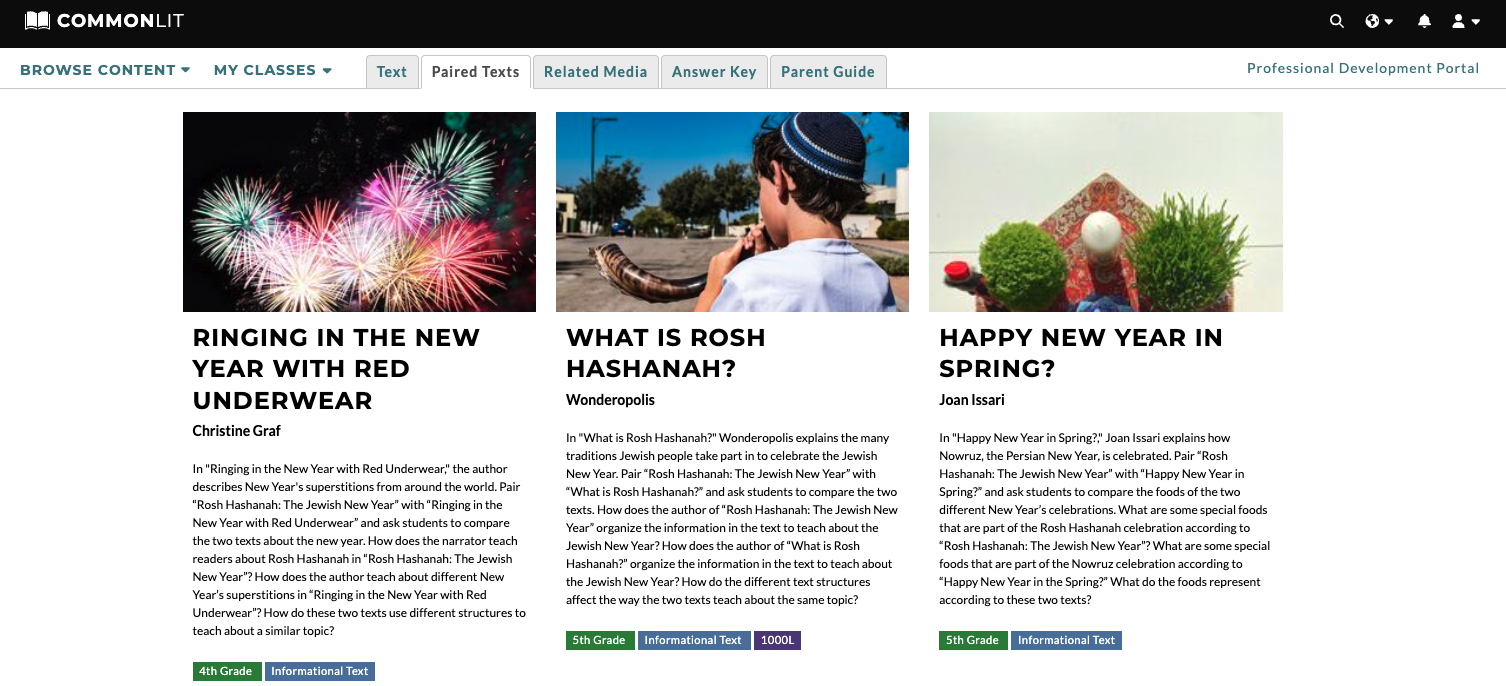 Elementary Classrooms
6 Elementary Texts to Ring In New Years Around The World
Elementary Classrooms
6 Elementary Texts to Ring In New Years Around The World
As the New Year approaches, bring multicultural learning to your classroom with these stories about New Year’s celebrations across different countries, cultures, and faiths.
Holiday celebrations are a great way to learn about cultures around the world. The CommonLit library is home to plenty of holiday texts to engage your students and explore new cultures. Our digital literacy program comes with tools that will help students build reading comprehension and reach benchmark ELA standards.
“Ringing in the New Year with Red Underwear” by Christine Graf (4th grade)
This informational text teaches about New Year’s superstitions from around the world – including the Philippines, Italy, Ecuador, Mexico, Turkey, and more. Many of these traditions involve food and stem from a desire to ward off evil spirits and ensure wealth and happiness in the new year.
After reading, engage students with Discussion Question 1, “Does your family take part in any of the New Year’s superstitions in the text? If not, how does your family celebrate the new year? Are there any superstitions you take part in that are not in the text?”

“Great Splashes” by Joan Bone (4th grade)
In Thailand, New Years is celebrated with a water festival called Songkran. In this story, a young girl and her family celebrate the holiday by enjoying special foods and throwing water.
Have students synthesize their understanding and showcase their reading comprehension by responding to Assessment Question 5, “How do people celebrate the Songkran water festival?” The assessment questions featured on all CommonLit reading lessons are built specifically to prepare students for success on rigorous benchmark assessments.
“Rosh Hashanah: The Jewish New Year” by Debra Friedland Katz (5th grade)
This text describes Rosh Hashanah, the beginning of the Jewish New Year and one of the holiest days of the Jewish year. The narrator describes her family’s traditions for the holiday, including a symbolic dinner, spending time reflecting on the previous year, and holy traditions at her synagogue that follow the Torah’s commands.
Read this text alongside “What is Rosh Hashanah?” from the Paired Texts tab and ask students to compare the two texts. How do the different text structures affect the way the two texts teach about the same topic?

“Happy New Year in Spring?” by Joan Issari (5th grade)
Nowruz, or New Day, is a holiday in Iran that celebrates the rebirth of earth and all life on it. The holiday dates back five thousand years to ancient Mesopotamia. This informational text highlights the traditions of Nowruz’ thirteen days of festivities.
Spark a conversation with Discussion Question 2, “At the end of the text, the author invites you to use tea and sweets to join the Nowruz celebration. Which customs from the text would you like to try?”
“New Year’s Eve New York City Style” by Christine Graf (5th grade)
In this informational text, Graf shares about the New Year’s Eve celebration in New York City. The text explains how a newspaper businessman made Times Square the place to be on New Year’s, and how a Russian immigrant invented the famous ball drop.
After reading, show students the video “Times Square 2022 Ball Drop in New York City” from the Related Media tab. Ask students how the video adds to their understanding of the Times Square New Year’s Eve celebration. Did the video help them understand what the ball drop looks like or the size of the crowd? Based on the text and video, would they like to celebrate New Year’s Eve in Times Square? Why or why not?

“Celebrating the Lunar New Year” by Jessica McBirney (7th grade)
This informational text is great for teaching about the range of holiday celebrations around the world. Many countries and cultures use lunar calendars, based on the phases of the moon, which determines when their new year's celebration falls each year. In the text, students will learn about Chinese new year, along with other Lunar New Year celebrations across Asia and Africa.
Encourage multicultural learning by starting a class discussion using Discussion Question 1, “This article discusses the new year's celebration of several Asian cultures. Why is it important to learn about other cultures and traditions? How does learning about other cultures help us to better understand our community and the world around us?”
Next Steps
Interested in learning more about how to promote multicultural learning in the classroom? Check out our Cultures Around the World text set or our CommonLit library for more resources!
If you’re interested in learning all about CommonLit’s free digital literacy program, join one of our webinars.


